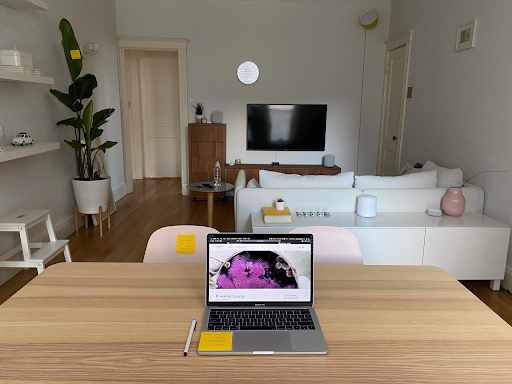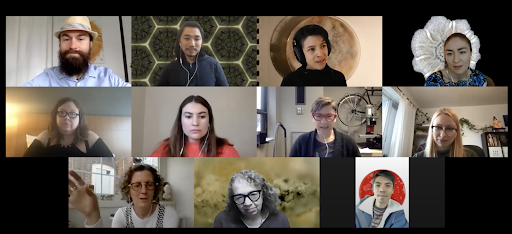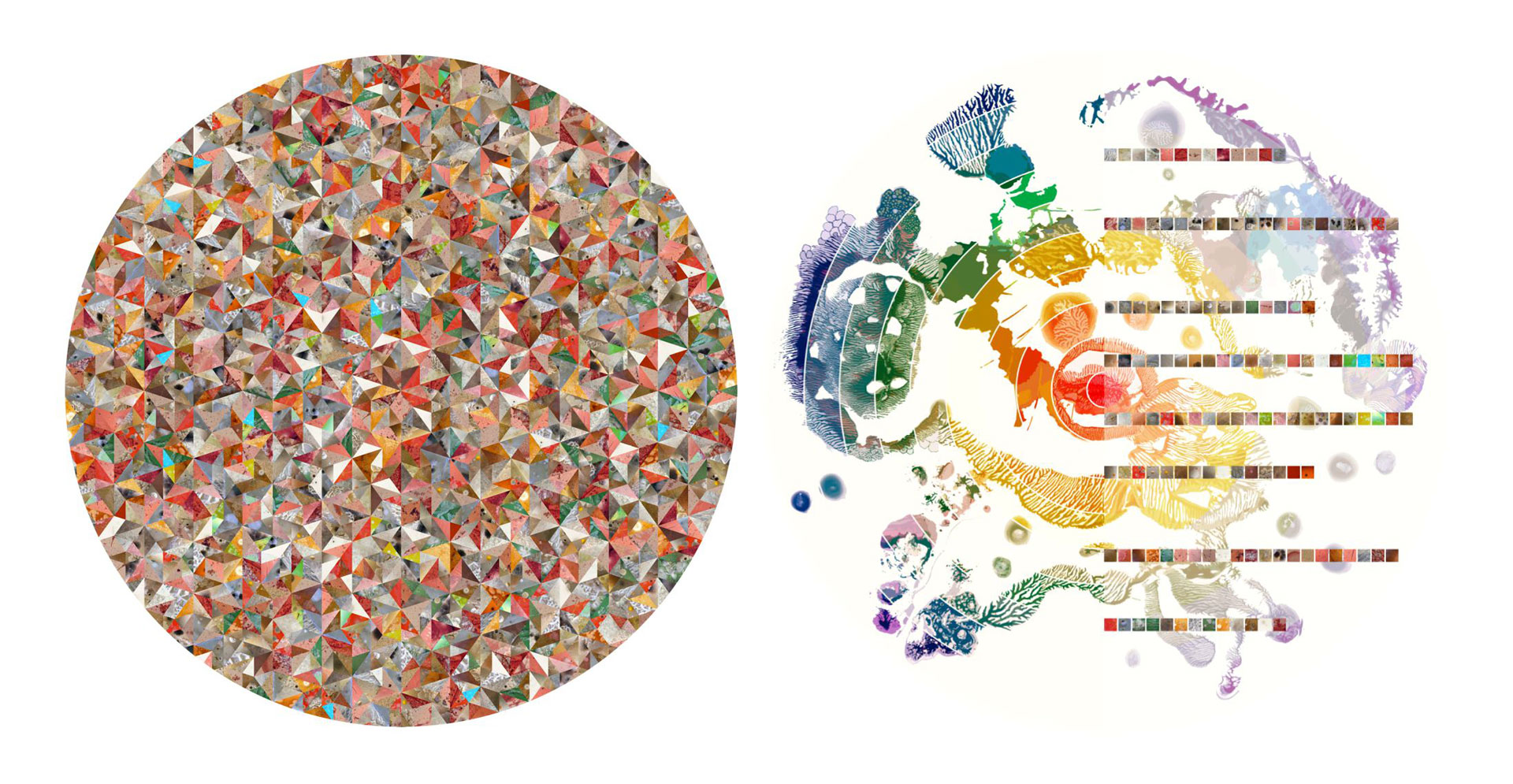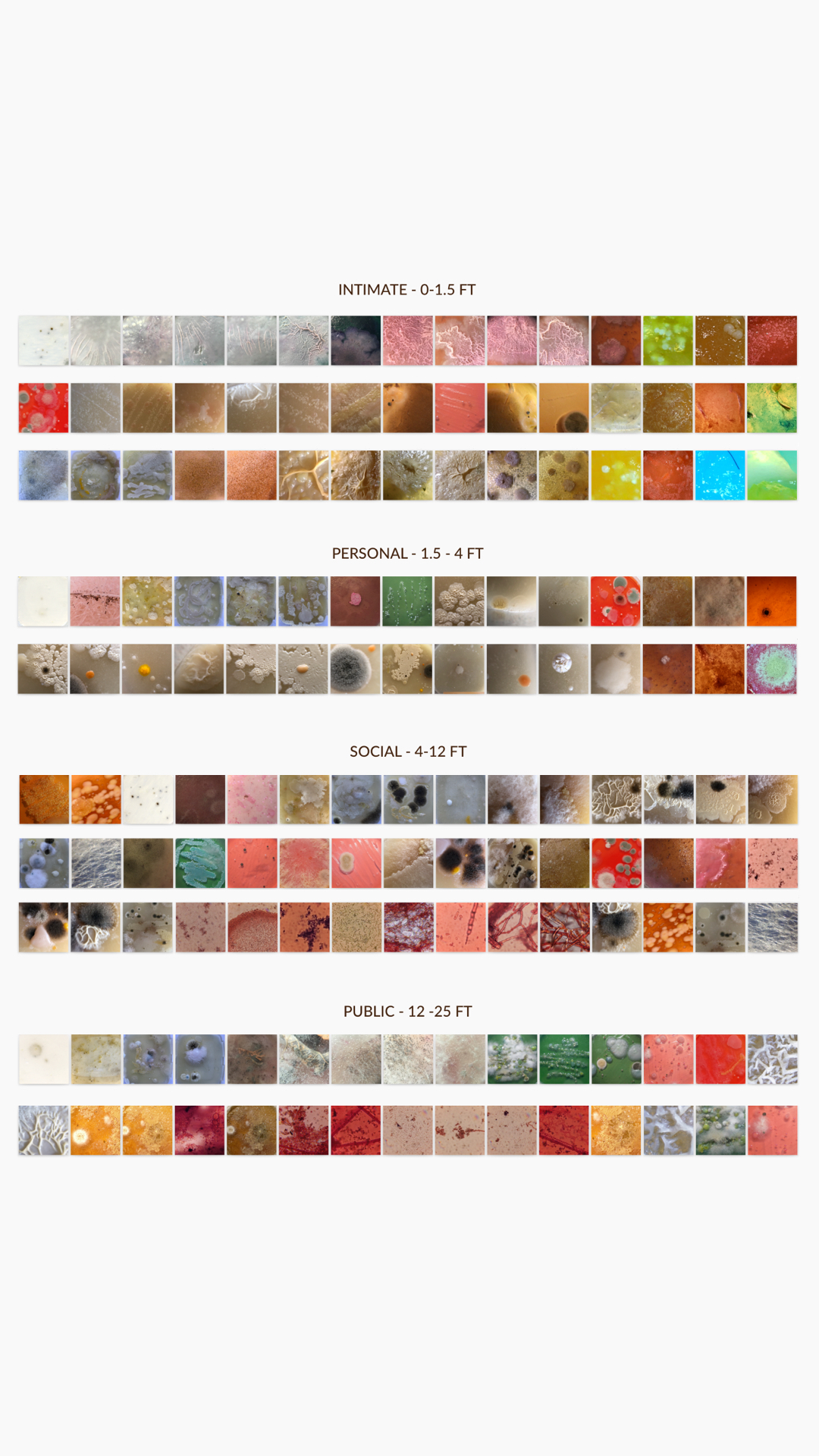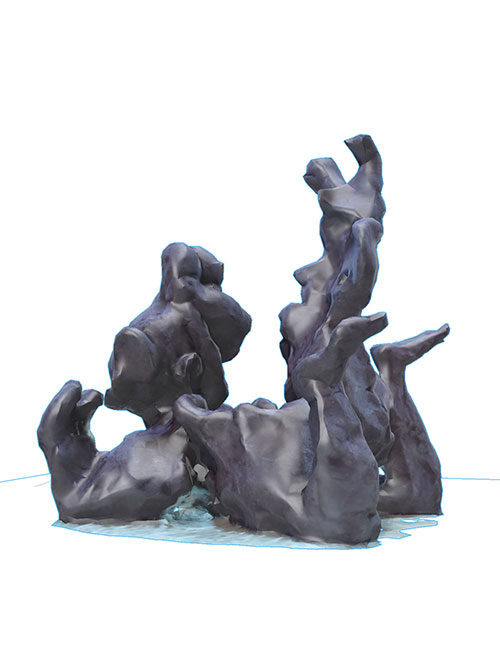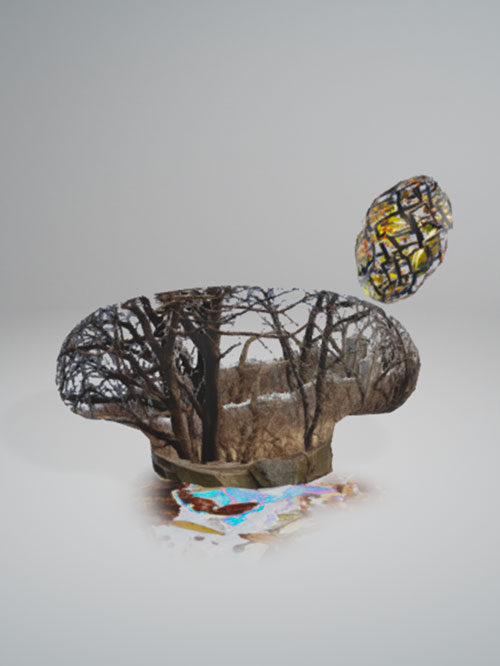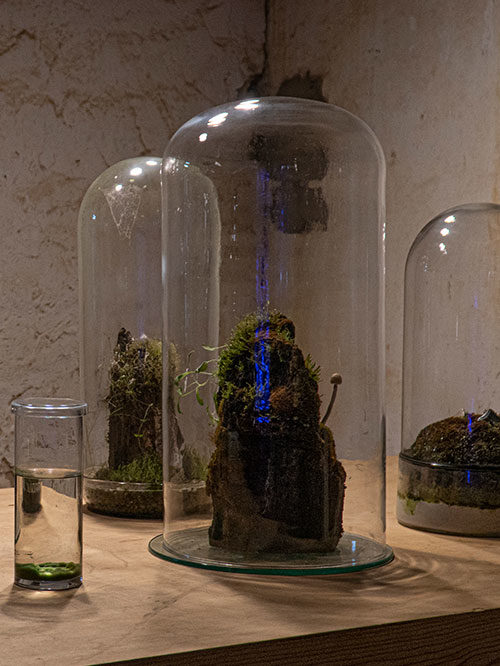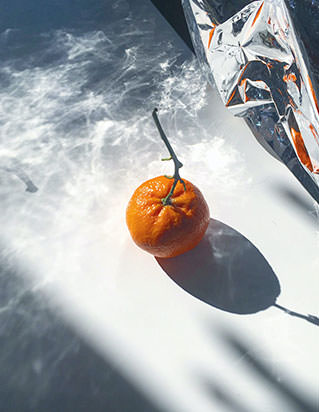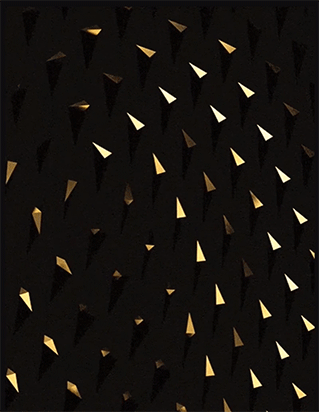JOEL ONG & ELAINE WHITTAKER | Proximal Spaces
Keywords
Microbiome | Microbes | Proxemics | Growth
What continues to thrive in the 6ft ‘dead spaces’ between us? What invisible particles linger on and create a biological archive through our movements through space?
Artistic Directors: Joel Ong, Elaine Whittaker
Graphic Designer: Natalie Plociennik Bhavesh Kakwani
AR development : Sachin Khargie, Ryan Martin
Bioartists: Roberta Buiani, Nathalie Dubois Calero, Sarah Choukah, Nicole Clouston,Jess Holtz, Mick Lorusso, Maro Pebo, Felipe Shibuya
Synopsis
Proximal Spaces’ is a multi-modal exhibition that explores the environment at multiple scales in concentric circles of proximity to the body. Inspired by Edward Hall’s 1961 notation of intimate (1.5ft), personal (4ft), social (12ft) and public (25ft) spaces in his “Proxemics” diagrams, the installation portion presents similar diagrams of his concentric circles affixed to the wall of the gallery space, as well as developed in Augmented Reality around the venue. Each of these diagrams is a montage of microscopic and sub-microscopic images of the everyday environment as experienced by a collaborative team of international bioartists, and arrayed in a fractal form. In addition, an AR-enabled application explores the invisible environments of computer generated bioaerosols suspended in the air of virtual space.
This work visualizes the variegated response of the biological environment to unprecedented levels of physical distancing and self-isolation and recent developments in vaccine design that impact our understanding of interpersonal and interspecies ‘messaging’. What continues to thrive in the 6ft ‘dead spaces’ between us? What invisible particles linger on and create a biological archive through our movements through space? The artwork presents an interesting mode of interspecies engagement through hybrid virtual and physical interaction.
In the spring of 2021, six Canadian poets – Kelley Aitken, nancy viva davis halifax, Maureen Hynes, Anita Lahey, Dilys Leman, & Sheila Stewart – came together to pursue a lyric response to Proximal Spaces. They were challenged and inspired by the virtual exhibition with its combination of art, science, and proxemics. The focus of the artworks – what inhabits and thrives in the spaces and environments where we live, work, and breathe—generated six distinctive poems.
The poems and information on each poet can be found here: http://www.proximalspaces.com/proximalpoems/
Artist Bio
Elaine Whittaker
Elaine Whittaker is a Canadian visual artist working at the intersection of art, science, medicine, and ecology. She considers biology as contemporary art practice and as the basis for her installations, sculptures, paintings, drawings, and digital images. Whittaker has exhibited in art and science galleries and museums in Canada, France, Italy, UK, Ireland, Latvia, China, South Korea, Australia, Mexico, and the U.S. Artwork created as Artist-in-Residence with the Pelling Laboratory for Augmented Biology (University of Ottawa) was exhibited in La Fabrique du Vivant at the Pompidou Centre, Paris in 2019. She was one of the first Artists-in-Residence with the Ontario Science Centre in partnership with the Museum of Contemporary Art Toronto. Her work has also been featured in art, literary, and medical magazines, and books, including Bio Art: Altered Realities by William Myers (2015).
Joel Ong (PhD. Digital Arts and Experimental Media (DXARTS, University of Washington)
Joel Ong is a media artist whose works connect scientific and artistic approaches to the environment, particularly with respect to sound and physical space. Professor Ong’s work explores the way objects and spaces can function as repositories of ‘frozen sound’, and in elucidating these, he is interested in creating what systems theorist Jack Burnham (1968) refers to as “art (that) does not reside in material entities, but in relations between people and between people and the components of their environment”.
A serial collaborator, Professor Ong is invested in the broader scope of Art-Science collaborations and is engaged constantly in the discourses and processes that facilitate viewing these two polemical disciplines on similar ground. His graduate interdisciplinary work in nanotechnology and sound was conducted at SymbioticA, the Center of Excellence for Biological Arts at the University of Western Australia and supervised by BioArt pioneers and TCA (The Tissue Culture and Art Project) artists Dr Ionat Zurr and Oron Catts.
Roberta Buiani
is an interdisciplinary artist, media scholar and curator based in Toronto. She is the co-founder of the ArtSci Salon at the Fields Institute for Research in Mathematical Sciences (Toronto) and co-organizer of LASER Toronto. Her recent SSHRC-funded research creation project draws on feminist technoscience and on collaborative encounters across the sciences and the arts to investigate emerging life forms exceeding the categories defined by traditional methods of classification. Her artistic work has travelled to art festivals (Transmediale; Hemispheric Institute Encuentro; Brazil), community centres and galleries (the Free Gallery Toronto; Immigrant Movement International, Queens, Myseum of Toronto), and science institutions (RPI; the Fields Institute). Currently, she is a research associate at the Centre for Feminist Research at York University. ArtSci Salon website: https://artscisalon.com Personal http://atomarborea.net
Nicole Clouston
Nicole Clouston is a practice-based researcher and teacher who completed her Ph.D. in Visual Art at York University in Toronto. In her practice, she asks: What happens when we acknowledge, through an embodied experience, our connection to a world teeming with life both around and inside us? Nicole has exhibited across Canada and internationally, most recently in Detroit, Michigan. She was the artist in residence at the Coalesce Bio Art Lab at the University at Buffalo and the artist in residence at Idea Projects: Ontario Science Centre’s Studio Residencies at MOCA Her work can be found at www.nicoleclouston.com.
Sarah Choukah
Sarah Choukah is a Toronto-based researcher, educator and artist. She currently invents and explores a hybrid creative approach to media and information technologies: a practice of gaze-shifting and interrogating everyday textures and contours —in particular those that seemingly, seamlessly define boundaries between form and matter, self and other, human and non-human, living and non-living, individual and collective.
Nathalie Dubois Calero
Bioartist and scientist (Ph.D. in plant science), my preferred media are GMO micro propagated cultures and micro-organisms -growing over a 10-foot floating fabric, in co-culture with Rochelle crystals, as an absurd security system. I am particularly interested in our skin, not as a barrier but as a communication and exchange space, and by our dermal microbiota, our millenary non-genetic and only maternal identity. My works are a feminist reflection about the world that we construct around us as supposed protection, a man-made nature we try to impose on the other organisms, on ourselves. Our intimate relationships with our microbiota, those non-human organisms that our immune system accepts as ourselves, is all together queer and ambivalent, full of love and hate. And the question of our real identity is open! Born in France and living in Montreal, Canada, I am affiliated with the Speculative Life Lab Cluster, Milieux Institute, Concordia University.
Bhavesh Kakwani
Bhavesh is a technology creative with a deep interest in the understanding and exploration of outer space. He developed a radiation instrument for the McMaster University satellite team, and tested it on high altitude balloon launches at NASA’s CSBF facility to prepare for orbital launch in 2021. He also crowdfunded, led and operated his own near-space balloon launch mission in Canada. Bhavesh currently works at SpaceRyde, where he is fulfilling his dream of designing rocket systems and propelling humanity forward to a renewed era of space exploration. You can contact Bhavesh through his email bk@bhave.sh
Jess Holz (b. 1985) creates artworks which give the viewer a peek into invisible worlds, as well as a chance to reflect on the influence of scientific visual culture on our collective imagination. She has just received an MFA in Art+Technology at the University of Wisconsin-Milwaukee; previously she has worked in several labs and imaging facilities, gaining valuable technical experience with a number of microscopic imaging techniques. Her award winning micrographs have been exhibited nationally and as far away as South Africa, and have garnered the support of the Frederick Layton Fellowship and UW-Milwaukee Chancellors Award. The discrepancy between what can be perceived by eye and what is imaged by the microscope has fostered her fascination with perceptual systems along with the optical properties of materials. Jess actively exploits this in photography and installation.
Mick Lorusso is a cross-disciplinary artist who creates images, cabinets of curiosity, and interactions to address questions about biophysics, energy, water, climate, and health. His residencies include: PLAND / ISEA 2012:Machine Wilderness (Taos, NM, USA), the Rauschenberg Rising Waters Confab (Captiva, FL, USA), and Matza Aletsch in the Swiss Alps. At a residency in Schöppingen, Germany, Lorusso harnessed electricity-producing bacteria to illuminate a sculptural village, Microbial Schöppingen, a hybrid art honorary mention at Ars Electronica 2013. With training in microbiology and Kundalini Yoga and in art at Colorado College (BA) and San Francisco Art Institute (MFA), he is a STEAM educator at Westridge School in Pasadena, CA and an instructor for the UCLA Sci|Art Studio+Lab.
Maro Pebo. Born in Mexico City. PhD in Creative Media (HK), MA in Gender Studies (IT) and BA in Art History (MX). Specializes in the intersections of art, science, and biotechnology. Her current interest lies in microorganisms’ culture and a microbial posthuman turn. Senior lecturer in Moist Media at the DeTao Masters Academy SIVA Shanghai. Maro has presented her research internationally including at ISEA, EVA, ISCMA and Media Art Histories, co-curated the Open Systems salon, the HK Leonardo Art Science Rendezvous and was involved in the Mexican Pavilion of the 56th Venice Biennale. Currently working on fostering post-anthropocentric microbiology literacy in society. @maro_pebo
Natalie Plociennik
Natalie is a Traditional Fine Artist and Multimedia Creative in Toronto focusing on surreal bio form paintings and digital media. She draws inspiration from her background in Earth & Environmental Sciences from McMaster University, Fine Arts from Centennial College and her professional experience in graphic design. Natalie’s biomorphic art has been featured in a myriad of venues such as the TTC, North Carolina State University, Toronto Maker Festival, and the Artist Network Gallery. You can contact her on Instagram @nataliegallery, or visit her website www.natalie.gallery.
Felipe Shibuya was born in 1986, in São Paulo, Brazil. He studied Ecology and Nature Conservation at the Federal University of Paraná, Brazil, where he earned his Ph.D. Currently, he is an M.F.A. candidate in Studio Art at the University at Buffalo, working at the intersection between biology and art. Felipe is also a laboratory teaching assistant at the Coalesce: Center for Biological Art. In his scientific-artistic research, he always highlights the visuality of nature, such as the colors and shapes of bacteria. Felipe’s work has been exhibited in the United States, Canada, Portugal and Germany, and has citations published in magazines such as National Geographic, Citylab, and Ecology.
References
Hall, E. T. (1974). Handbook for Proxemic Research. Society for the Anthropology of Visual Communication.
Yong, E. (2016). I Contain Multitudes: The Microbes Within Us and a Grander View of Life (Illustrated edition). Ecco.


